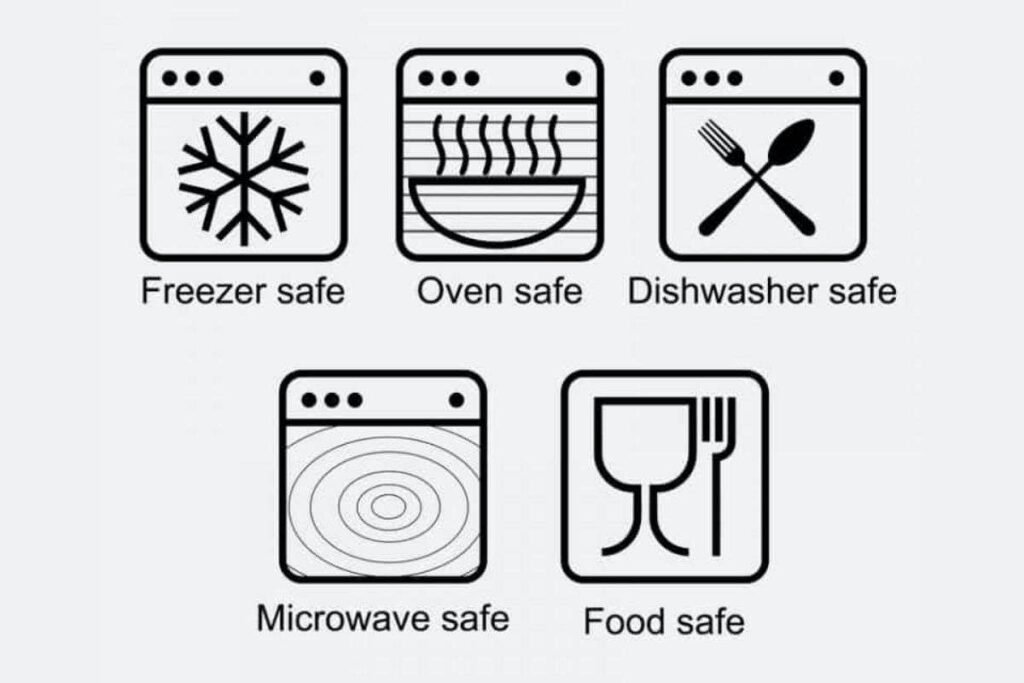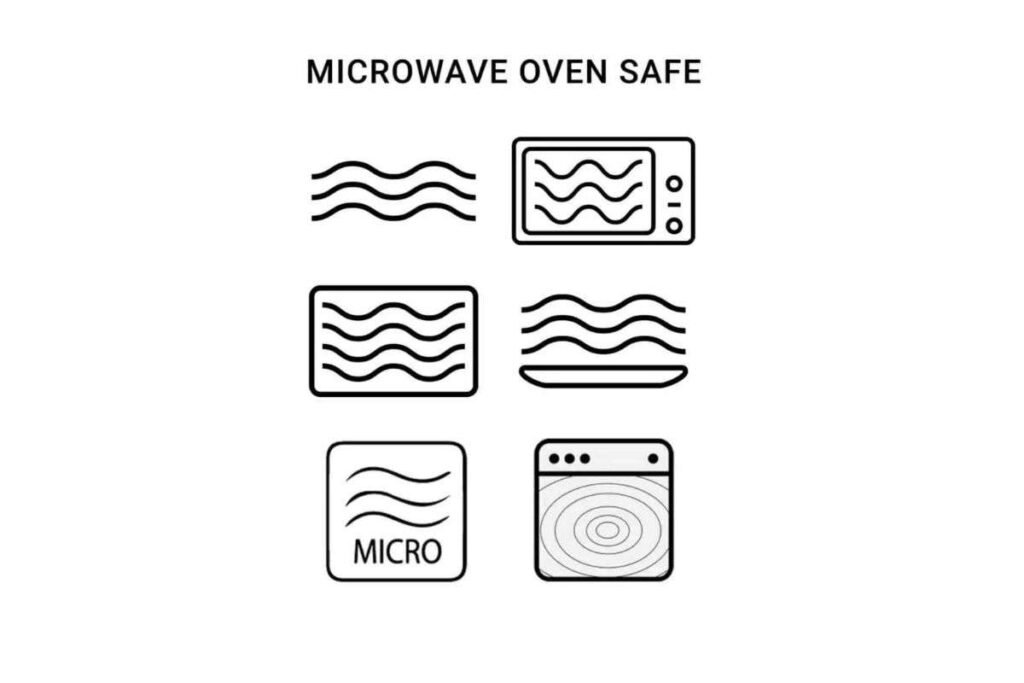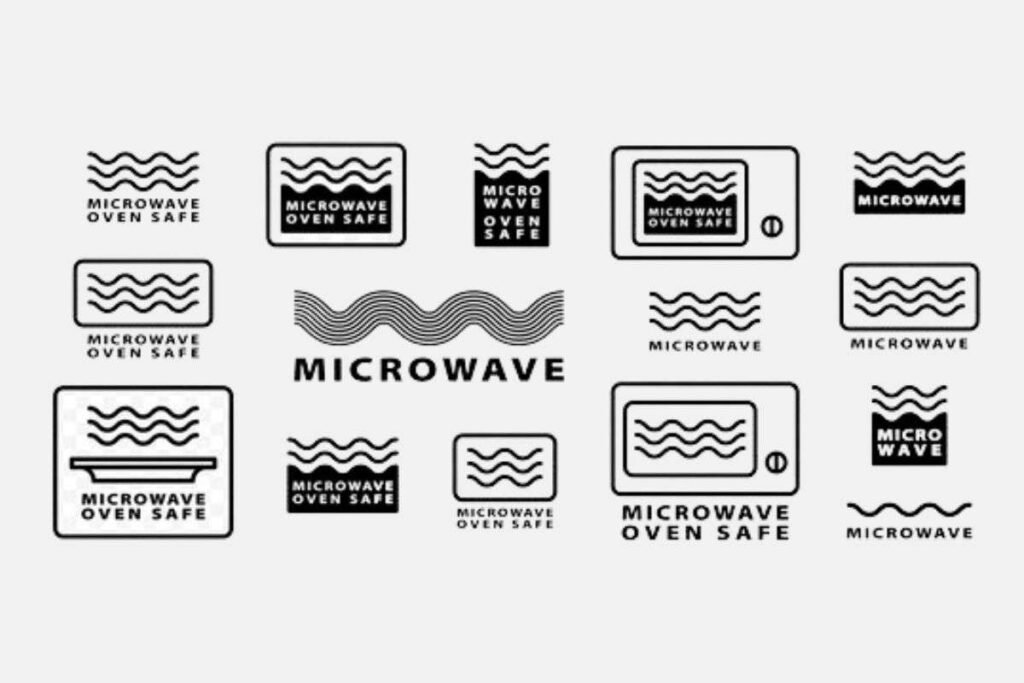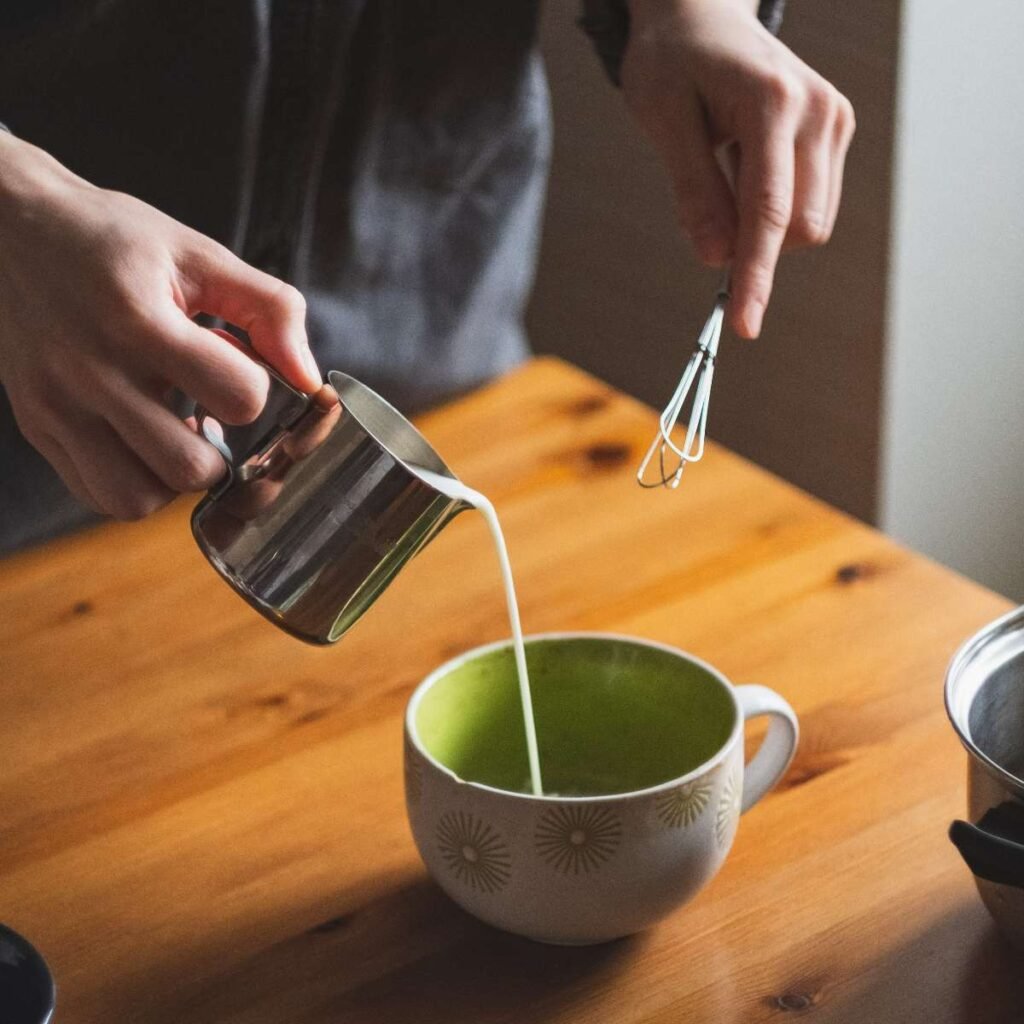Have you ever found yourself wondering whether a particular container is safe to use in the microwave? It’s a common question and for good reason. Using the wrong container in the microwave can be dangerous and can even damage your microwave. In this post, we’ll be discussing how to tell if a container is microwave safe and what to look out for when choosing a container to use in the microwave.
Whether you’re a seasoned microwave user or a beginner, this post is for you. So let’s get started!
Understanding Microwave-Safe Containers
Microwave-Safe Symbols
When checking if a container is microwave-safe, the first thing to look for is the microwave-safe symbol.

This symbol usually consists of a microwave icon with wavy lines, as the previous picture shows.
Finding this symbol on your container indicates it is safe for microwave use.
Be aware that some containers might have written labels such as “Microwave Safe” or “Not for Use in Microwaves” instead of the symbol.
Types of Containers
Various materials are used to make microwave-safe containers. Each has its benefits and precautions to consider.
Ceramic: Ceramic containers are generally microwave-safe if they don’t have any metallic parts or designs. Make sure to check for any hairline cracks, as these can cause the container to break during microwave use.
Glass: Glass containers are usually safe for the microwave, particularly those labelled as microwave-safe or made from borosilicate glass. Avoid using cracked or chipped glassware in the microwave to prevent breaking.
Plastic: Some plastics are microwave-safe, but you need to be sure of their safety before using them. Look for the microwave-safe symbol or check the label for microwave-safe indications.
Keep in mind that even so-called “microwave-safe” plastics can still potentially release chemicals into your food.
Paper: Paper plates, cups, and some paper food containers can typically be used in the microwave. However, make sure they don’t have any metallic decorations or parts.
Avoid using containers made of aluminum, metal, or Styrofoam in the microwave.
Aluminum and metal cause fires, while Styrofoam can release harmful chemicals into your food.
When in doubt, stick to using ceramic, glass, and properly labelled plastic or paper containers to ensure your safety and preserve the quality of your food.
Materials to Avoid in Microwaves
Aluminum and Metal Containers
Avoid using aluminum and metal containers in the microwave. These materials can cause electric sparks, damaging your microwave and posing a fire hazard.
Instead, opt for microwave-safe materials like glass, ceramic, or certain types of plastic.
Check: Are sandwich bags microwave-safe?
Styrofoam and Polystyrene
Styrofoam, also known as polystyrene, is not microwave-safe. When heated, it can melt, release harmful chemicals, and contaminate your food.
Avoid using Styrofoam containers in the microwave to keep your food and microwave safe.
BPA and Toxic Plastics
Bisphenol A (BPA) is a toxic chemical found in some plastic containers, such as those made from PETE or PVC.
Exposure to BPA has been associated with various health hazards.
When microwaving your food, ensure that the container is labelled as microwave-safe and free of BPA and other harmful chemicals.
Look for containers made from polypropylene (PP) or those labelled as #5, as these are generally considered safer options.
Microwave-Safe Plastics
PETE Containers
PETE (Polyethylene Terephthalate) is a type of plastic often used for food storage containers. You can identify these containers by looking for the recycling code number “1” on the bottom. PETE is generally considered microwave safe as it doesn’t contain any harmful chemicals like phthalates.
However, it’s essential to ensure the specific container you’re using is labelled as “microwave safe” or has the special microwave safe symbol with wavy lines along with the recycling code.
To use PETE containers in the microwave, follow these tips:
- Always ensure the container is microwave safe before using it.
- Avoid using containers with visible wear and tear, as they may become unsafe over time.
Polypropylene Containers
Polypropylene (PP) is another common plastic material used for food storage containers. You can identify these by checking for the recycling code number “5” on the bottom of the container. Polypropylene containers are considered safe for microwave use if they are specifically labelled as such or if they carry the imprinted microwave symbol.
When using polypropylene containers in the microwave, keep these pointers in mind:
- Make sure the container is marked as microwave-safe or has the imprinted microwave symbol.
- Replace worn-out containers, as they may become unstable and unsafe for microwave use.
Remember that while both PETE and polypropylene containers can be microwave safe, it’s crucial to check for specific labelling and the proper symbols before using them in the microwave. Always prioritize your safety and adhere to the manufacturer’s guidelines when heating your food in plastic containers.
Using Alternative Materials
Glass and Ceramic Containers
Using glass and ceramic containers in the microwave is generally a safe option. Make sure the containers are free of any metallic parts or elements, as these can cause sparks and damage your microwave. Refrain from using any cracked or chipped glass or ceramic dishware, as they may not be heat-resistant.
Paper Products in the Microwave
When using paper products in the microwave, stick to items specifically designed for microwave use.
Options such as parchment paper, paper towels, and paper plates are usually safe and make for easy cleanup.
However, avoid using PVC or plastic-containing paper products, as these may release harmful chemicals when heated.
Here are some paper products to consider using in the microwave:
- Parchment paper: This non-stick, heat-resistant paper is great for reheating food or covering dishes to prevent splatters.
- Paper towels: Use them to cover food and absorb extra moisture. Make sure to choose a microwave-safe brand.
- Paper plates and bowls: Opt for microwave-safe paper bowls and plates when planning a quick meal or reheat. They’re usually safe and provide easy cleanup.
- Napkins: Napkins can be safely used in the microwave to cover small items or to absorb steam from vegetables.
However, it’s best to avoid using brown paper bags as they can release harmful chemicals and may even catch fire. Always opt for microwave-safe options and follow proper guidelines to keep your food and microwave safe.
Ensuring Container Safety
Heating Test
One way to check if a container is microwave-safe is to perform a simple heating test.
Fill a microwave-safe cup with water and place it alongside your container in the microwave. Heat the contents for one minute.
If the container is cool and the cup of water is hot, your container is microwave safe.
However, if the container becomes warm or hot after heating, it’s best not to use it in the microwave.
Proper Labeling
Another essential factor in ensuring container safety is to look for proper labelling on the packaging.

Manufacturers are required to label their products with information regarding microwave safety.
Check for the FDA-approved symbol indicating that a plastic container is microwave safe, which is usually present on the bottom of the container.
If you find this microwave-safe symbol, you can be confident that your container meets the appropriate safety standards.
Adhering to Microwave Recommendations
Lastly, follow the microwave oven recommendations provided by the Food and Drug Administration (FDA) and the United States Department of Agriculture (USDA).
These recommendations ensure the health and safety of your food when using containers in the microwave.
These guidelines include avoiding the use of containers made with harmful chemicals, as they can release molecules into your food during the heating process.
Avoiding Common Mistakes
Now, let’s discuss how to avoid common mistakes when using microwave-safe containers.
Covering Food with Unsafe Materials
Always be cautious when covering your food in the microwave. Using improper materials can cause harm to your food, the container, or the microwave itself.
It’s important to avoid using materials like aluminum foil and certain types of plastic wrap, as they may not be microwave safe.
Instead, opt for microwave-safe materials such as parchment paper, wax paper, or microwave-safe lids.
Not Stirring Food
When heating food in the microwave, it’s essential to stir the contents periodically. Microwaves heat food unevenly, so stirring ensures that hotspots don’t form, which can cause some parts of your food to overcook or burn.
This also ensures that your food heats more evenly, providing a more consistent temperature throughout the dish.
Take the time to pause the microwave and give your food a quick stir to guarantee a better heating experience.
Eco-Friendly and Reusable Container Options
Smart Set Pro and Proview Containers
When it comes to eco-friendly and microwave-safe containers, Smart Set Pro and Proview containers are excellent options.
These containers are made from polypropylene, which is known to be microwave-safe and doesn’t leach harmful chemicals into your food.
Smart Set Pro and Proview containers offer the convenience of single-use plastic without environmental harm.
They are reusable and durable, so you can rely on them for food storage and microwaving needs.
Glass Food Storage Containers
Another great choice for eco-friendly and microwave-safe food storage is glass containers.
Glass is a fantastic alternative to plastics since it doesn’t contain harmful chemicals which can leak into your food when heated.
Not only are glass containers safer for you, but they are also more sustainable than single-use plastics.
Glass food storage containers come in various shapes and sizes, making them versatile for storing your meals and snacks.
They are easy to clean and can go straight from the refrigerator to the microwave. As an added benefit, glass containers don’t retain odours and stains as much as plastic containers do.
By using eco-friendly and reusable containers like Smart Set Pro, Proview, and glass food storage containers, you are making a conscious decision to minimize your environmental impact while ensuring the safety of your food.
So, keep an eye out for these options the next time you need to store and reheat your meals.
Now you know how to tell if a Container is Microwave Safe.
Frequently Asked Questions
What is the microwave-safe symbol?
The microwave safe symbol is a unique icon that signifies a container is safe for use in a microwave. It typically features a microwave image with wavy lines inside it. When you see this symbol, it indicates that the material of the container has been tested and confirmed to safely withstand microwave heating conditions. Here’s an example of a microwave-safe symbol.

Which materials are not safe for the microwave?
Materials such as metal, including aluminum foil, and some plastics like APET (E) #1, are not safe for microwave use. These materials can cause arcing (sparks) or uneven heating in the microwave, posing a potential hazard. Always verify whether a container is microwave safe before using it to heat food.
How do I find the microwave-safe label on containers?
To locate the microwave-safe label, turn the container over and carefully examine the bottom surface. Look for the microwave safe symbol or text explicitly stating that the container is “Microwave Safe” or “Not for Use in Microwaves.” If it’s unclear, consider checking the manufacturer’s website or container packaging for further information.
What numbers on plastic containers indicate microwave-safe?
Some plastic containers have a “resin identification code” indicating the type of plastic used. Containers made from CPET #1 are typically microwave safe, while other numbers like APET (E) #1 are not. However, it’s essential to use the presence of a microwave-safe symbol or label as your primary indicator for microwave safety.
Can polystyrene be microwaved safely?
Polystyrene containers (often used for takeaway food) usually aren’t recommended for microwave use. When heated, polystyrene can release harmful chemicals, risking your health and potentially damaging the food. It’s best to transfer the food to a microwave-safe container before heating.
What test can be done to check a container’s microwave safety?
If a container’s microwave safety is unclear, you can perform a simple test. Fill a microwave-safe glass bowl or cup with water and place it in the microwave alongside the container in question (ensure it’s empty).
Microwave them together for 1 minute. After heating, carefully check if the container’s surface is cold or barely warm to the touch. If so, it’s likely to be microwave safe. However, if the container is hot, it’s not suitable for microwave use. Always be cautious when performing this test, as the water and container can become extremely hot.



